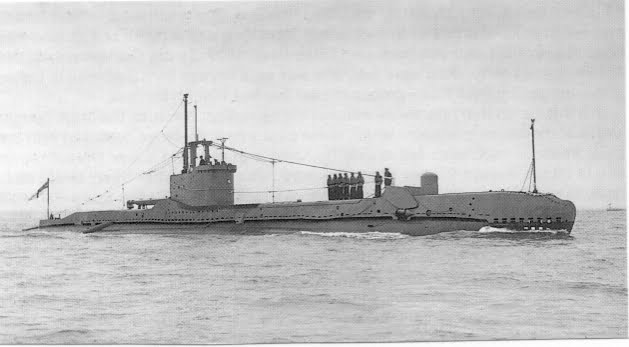
HMS Sidon
This submarine originally sank in Portland harbour due to an explosion and subsequent fire, which killed some of the crew. She was salvaged and sunk in her present position as a Sonar target and makes an excellent dive. The Sidon is upright and although intact there are many holes in her casing, which have attracted much fish life. One of my memories of this wreck was being on the conning tower and looking up to see the dive boat 25M above me a truly stunning sight for our waters.
Max depth 36M
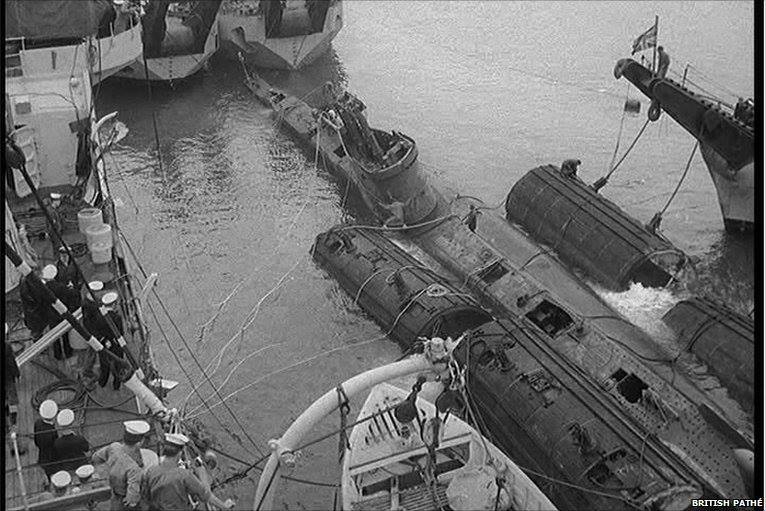
A 1950s SUBMARINE TRAGEDY COULD AID DEFP SEA RESCUE RESEARCH
The recent tragic sinking of the Russian nuclear submarine Kursk has prompted speculation that the tragedy may have been caused by an explosion in a torpedo powered by HTP (High Test Peroxide) fuel. If this is correct, there are certain parallels with a similar incident in the UK in the 1950s which, despite taking place in harbour and alongside ship, cost thirteen lives. HMS Sidon entered service in the last year of World War II. She commenced trials and working up training at Holy Loch during November 1944, the beginning of a relatively unremarkable career which was noted mainly for technical faults and minor incidents. After just two months at sea Sidon was damaged in an underwater collision with another Royal Navy submarine, HMS Turpin. Following repairs to a bent stem cutter she set off from Lerwick on 8 March 1945 for her working up patrol off the west coast of Norway, a known haunt of German U-boats The crew had navigation problems for the first few days as heavy rain and snow made it difficult to get a land fix. The weather cleared after three days, but the only reported sighting of the enemy was a lone JU-88 flying two miles away. Although flying at about 200 feet it’s crew did not appear to have spotted Sidon.
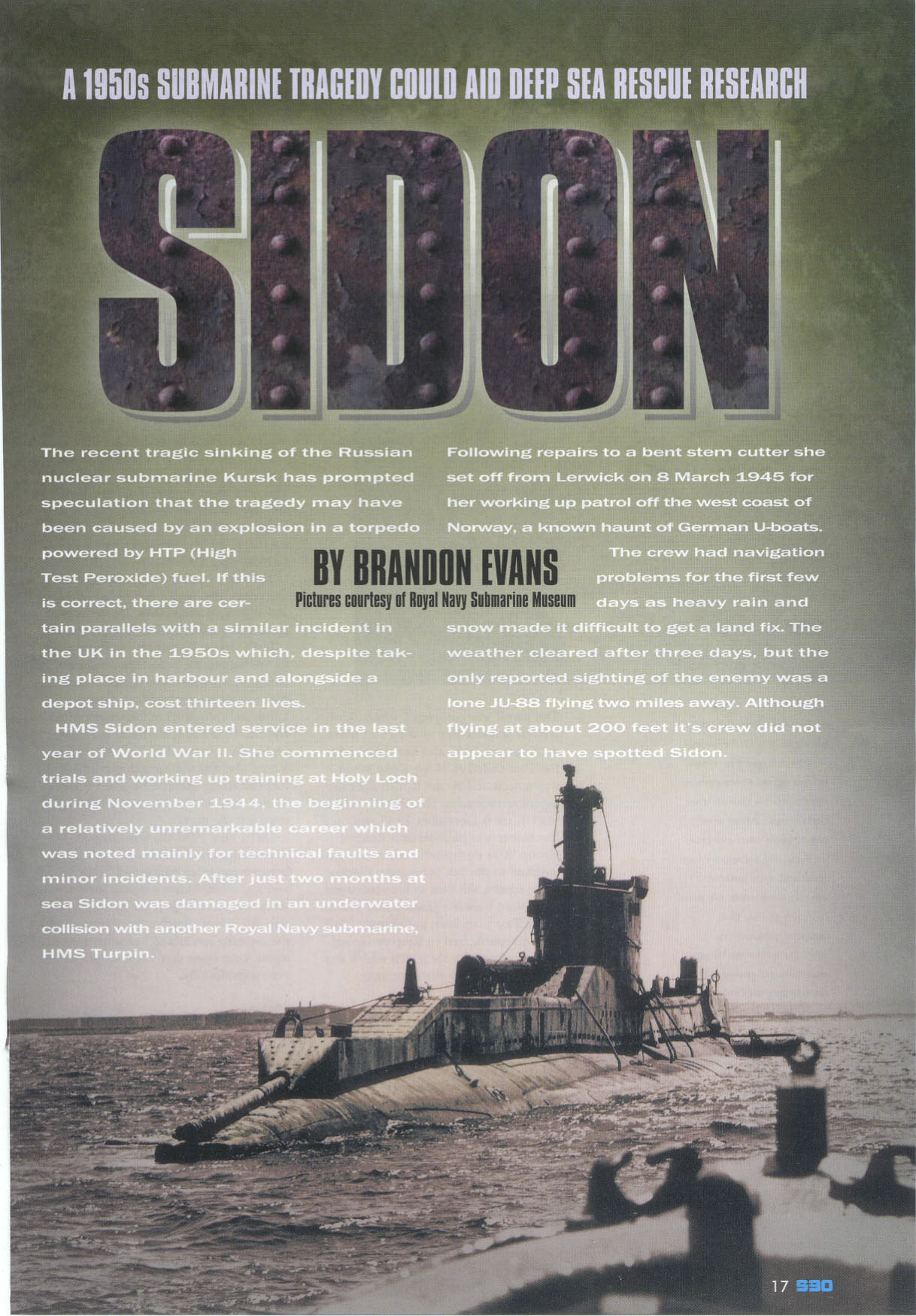
Heavy weather and rough seas for the remainder of the patrol meant that Sidon was unable to maintain periscope depth. By 23 March she was back at Lerwick before returning to Holy Loch where she was secured alongside SS AI Rawdah. On 7 April 1945, Sidon left Holy Loch to join the 8th Submarine Flotilla in the Far East, diverting to Freemantle en-route to repair her batteries. After the work was completed in July, she began her second war patrol which involved air sea rescue duty, but engine problems shortly after setting out forced another diversion to Onslow to carry out repairs.
Six days later she was back on patrol heading through the Lombok Straits and on 24 July was ordered to search for the crew of an American Liberator which had come down off Saigon. After four days of searching she rescued 2nd Lt. Stanley Reed USAAF. He had drifted 287 miles from the ditching position and had been adrift for five days with little food or water. The patrol report comments: “The joy on his face when he saw Sidon amply repaid all the fruitless searching and false hopes we had experienced’.
The patrol was completed when Sidon arrived at Subic Bay in the Philippines on 3 August 1945 and her time in the Far East ended in Hong Kong when it was reoccupied by the British after the Japanese surrender. She arrived back in the UK on 6 December 1945 and on 27 December was paid-off into Reserve Group ‘S’ at Portsmouth where she was attached to the 5th Submarine Flotilla. More repairs, this time to her armaments, took place between January and March 1946. Two years later, in February 1948, she was transferred to Reserve Group C at Portsmouth for a refit which was completed in June the same year.
In August, she was transferred once again, this time to Reserve Group ‘M’ at Portsmouth and fitted with ballast. Sidon had a second refit in 1950 at Sheerness in Kent. Post refit diving trials were successfully completed in June and on 20 July 1950 she towed the midget submarine XE8′ from Plymouth to Portsmouth. On 31 August she towed XE8 back to Plymouth and joined the 2nd Submarine Flotilla. On 19 April 1951 Sidon took part in the search for HMS/m Affray which had gone missing in the English Channel. Then she suffered another mishap when she touched the bottom during and exercise in June 1951, sustaining damage to the net cutter immediately below torpedo tubes five and six.
She was paid-oft into Reserve Group F attached to 5th Submarine Flotilla at Devonport in November 1951 where she was refitted and modernised. Her 4-inch gun and gun tower were removed and a snort mast and Type 267MW radar fitted. The refit was completed in June 1952 and she was re-commissioned into the 2nd Submarine Squadron, based at Portland, for submarine and anti-submarine training In November she was moved to Devonport to have an escape trunk fitted. The work was completed by the following January and in June of 1953 HMS Sidon took part in the Coronation Naval Review at Spithead.
In February 1953, she was transferred to 5th Submarine Squadron pending another refit which was undertaken at Birkenhead by her builders, Cammell Laird, and completed in November 1954. By June 1955 Sidon was based at Portland under the command of Lt Cmdr H T Verry. She was due to take part in a live torpedo firing exercise but the torpedoes being tested led to tragedy before she even left the port.
On 16 June 1955 she was alongside her depot ship, HMS Maidstone, tied up between two other submarines, HMS Subtle and a Danish V class sub, the Saelen. All three were due to join the exercise that day. All Sidon’s hatches were shut except the conning tower and her watertight doors were open save for the door to the port torpedo tube.
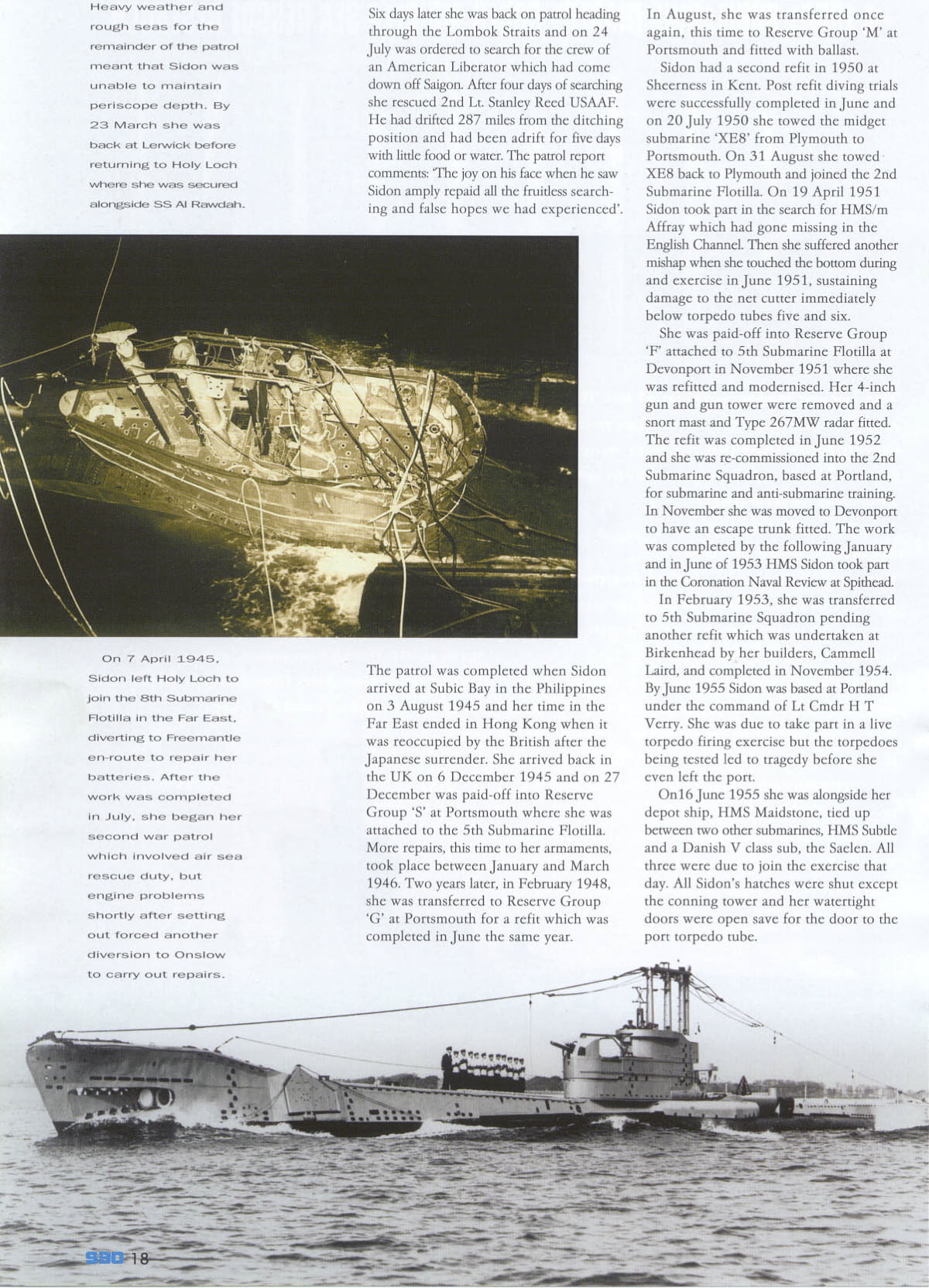
The torpedoes due to be test-fired were Mk 12s, converted Mk 8s equipped with an HTP (High Test Peroxide) motor similar to that used on German ‘Steinbut’ torpedoes which were produced towards the end of World War IL. Several Steinbuts had been captured in 1945 and their performance had impressed the Royal Navy. The Mk 12s, also known as ‘Fancy SR’ torpedoes, were intended for anti-submarine warfare and had a range of 20,000 yards. As many Mk 8s were still in stock it was considered cheaper to convert them rather than designing completely new torpedoes with HTP motors. Although this decision made economic sense, it was to prove disastrous for Sidon and her crew. The Mk 8s contained certain metals which could create a violent reaction if contacted by HTP. Gasses produced would expand at great speed and in the confined casing of a torpedo, cause a catastrophic explosion, which is exactly what happened that fateful morning
At 08:25 an explosion occurred in Sidon’s No. 3 torpedo tube. The force of the blast blew off the torpedo tube’s bows cap and the rear door and seawater flooded in through the tube. Parts of the torpedo were blown into the sea and other components were blown violently back into the submarine, causing major damage to the stowage compartment watertight door and bulkhead and decimating the crew space and wardroom. Toxic fumes rapidly filled the hull.
Lt Cmdr Verry was on the bridge and felt a blast of air. Smoke, debris and pieces of paper were coming from the conning tower hatch. He thought there had been a battery explosion but quickly realised the seriousness of what had happened when an injured crewman was brought up. After ordering the DSEA hatches to be opened Verry, wearing breathing apparatus, went below to carry out a damage assessment. He could make no progress forward because the bulkhead doors were jammed with wreckage from the explosion, so he returned to the bridge. He was not aware that while all this was happening the Maidstone had sent a sea rescue party with fire-fighting equipment and breathing apparatus. Although down by the bows, he was also unaware that water was pouring through the open tube and watertight doors and Sidon was actually sinking.
Commander Submarines realised that the sub was doomed and shouted the order to abandon ship across to Lt Cmdı Verry who passed the order down the conning-tower hatch. When everyone was believed to be clear, an attempt was made to close the after hatch but all efforts failed. It was therefore not possible to seal the submarine. Crew members aft of the wardroom when the explosion occurred survived and made an orderly evacuation, although many were dazed and confused. The torpedo party including the Squadron Armament Officer from HMS Maidstone, Lt Commander Needham and five ratings, died instantly. A second officer and five more ratings were injured and quickly overcome by fumes. They also died, together with Surgeon Lt CE Rhodes of HMS Maidstone who had boarded Sidon twice after the initial explosion to give medical assistance.
The lifting lighter Moordale, passing nearby tried to put a line around the stricken sub’s stern. The attempt failed and with her watertight doors open Sidon flooded and sank in the harbour just 20 minutes after the explosion. She lay 36 feet down, listing 25 degrees to starboard. A party of divers were despatched to Portland by helicopter and worked through the night to attach high pressure air hoses to her hull. The next day Sidon SID had settled on a more even keel and an attempt was made to salvage her by pumping in air, but because of numerous leaks the attempt failed. Two salvage vessels, Kinbrace and Swin, were sent from Dover, along with the Portsmouth based Barcross. The salvage team attached four camels, two each side of the wreck. Camels are hollow steel tubes that are naturally buoyant. They were flooded with water to make them sink, attached to the sides of the wreck and then pumped out.
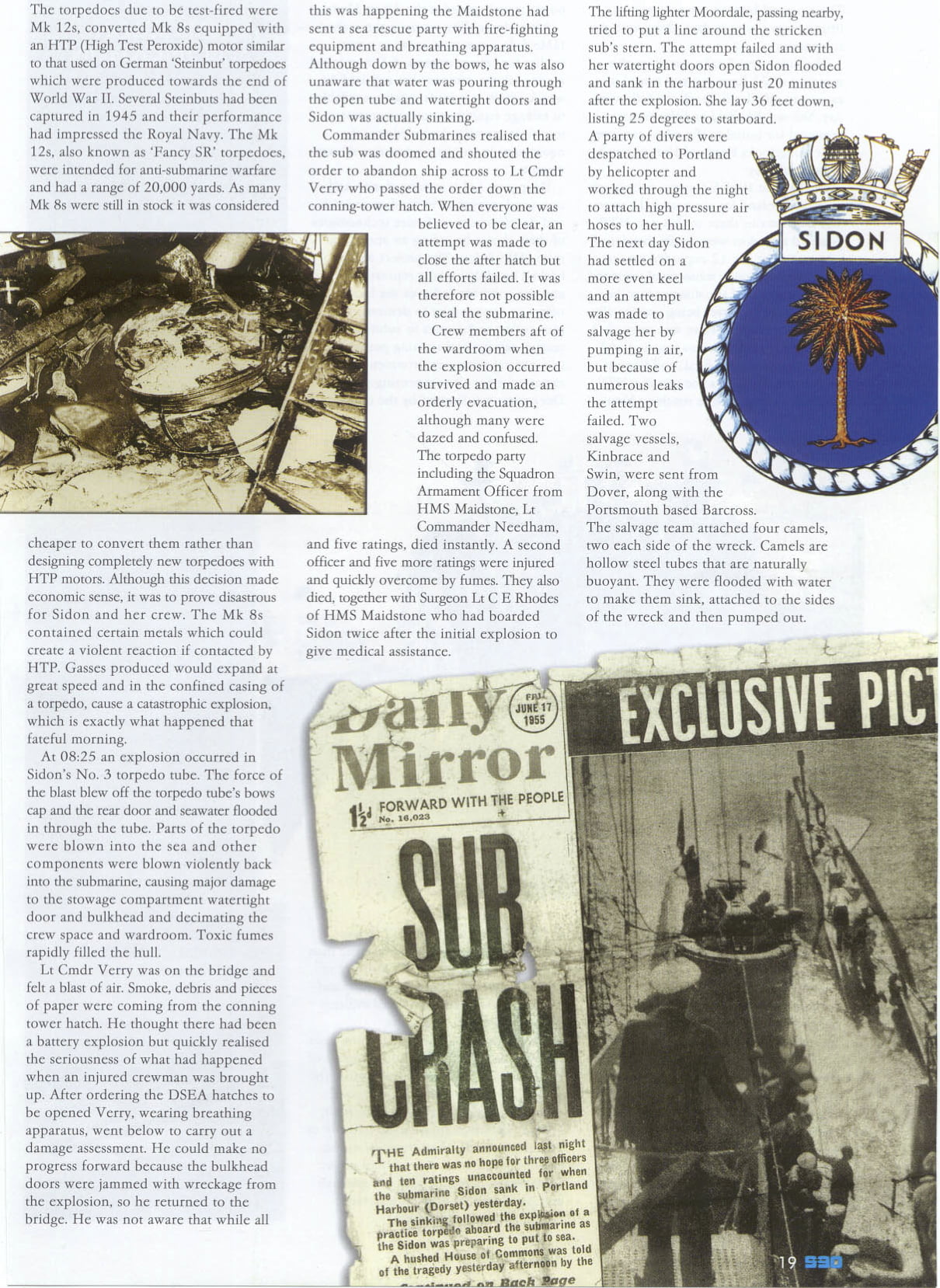
Their natural buoyancy would return, lifting them to the surface along with the submarine.
The Sidon was finally raised on the morning of 23 June and was towed to a causeway off Chesil Beach the following day. She was beached and the victims removed for burial in the naval cemetery which overlooks Portland Harbour and Weymouth Bay.
On 14 June 1957 Sidon was deliberately sunk off Portland for use as an asdic target and she remains there to this day. HTP powered torpedoes were finally abandoned when another Mk 12 exploded on test. The Board of Inquiry subsequently reported the likely cause of the disaster was the torpedo’s starting lever being accidentally moved when a stop valve was opened. A delay device had failed to function and the torpedo motor stalled, building up pressure which burst a line spraying HTP inside the torpedo. The resulting blast blew the torpedo tube open. The inquiry attached no blame to Lt Commander Verry or any officers or crew.
The Commander-in-Chief, Portsmouth, Admiral Sir George Creasy, issued an order commending both Lt Commander Verry and Lt Commander CF Allington from the Maidstone, who removed a torpedo from a tube in darkness and in a partly flooded compartment. Commissioned Engineer Hawkins was commended tor risking his life without a mask until he was overcome by fumes while ERA A Pearson and Chief Ordnance Artificer J W Ward, already mentioned in the report of the Board of Inquiry, also received commendations. Surg Lt Rhodes was posthumously awarded the Albert Medal.
After almost fifty years on the seabed, HMS Sidon may now serve as a test facility for salvage systems. A Dorset based marine salvage company has acquired the wreck which it intends making available to salvage equipment manufacturers to test their specialist knowledge and equipment in a unique submarine salvage attempt.
Deepquest Ltd is inviting marine and associated companies to conduct research and development on future technologies of their choice by aiding an attempt to raise HMS Sidon. The project will be backed by global media representation and the company believes the facility offers an opportunity to demonstrate pioneering techniques in submarine rescue, salvage and training participation in a natural subsea environment, gaining experience for all oceaneering persons. Deepquest was formed by the owners of CJ Evans Ordnance and C J Evans International, companies with more than 20 years experience of UK Ministry of Detence contracts, movie production and the acquisition and disposal of military hardware, aircraft, and ships.
The Sidon now lies in 34 metres of water off Weymouth and because all victims of the explosion were recovered before the submarine was scuttled, there are no contentious issues surrounding any future salvage attempt, experimental exercise or Simulated rescue. From tragedy and an ignominious end as an undersea target, HMS Sidon may now help aid research and development of deep sea rescue equipment and techniques.
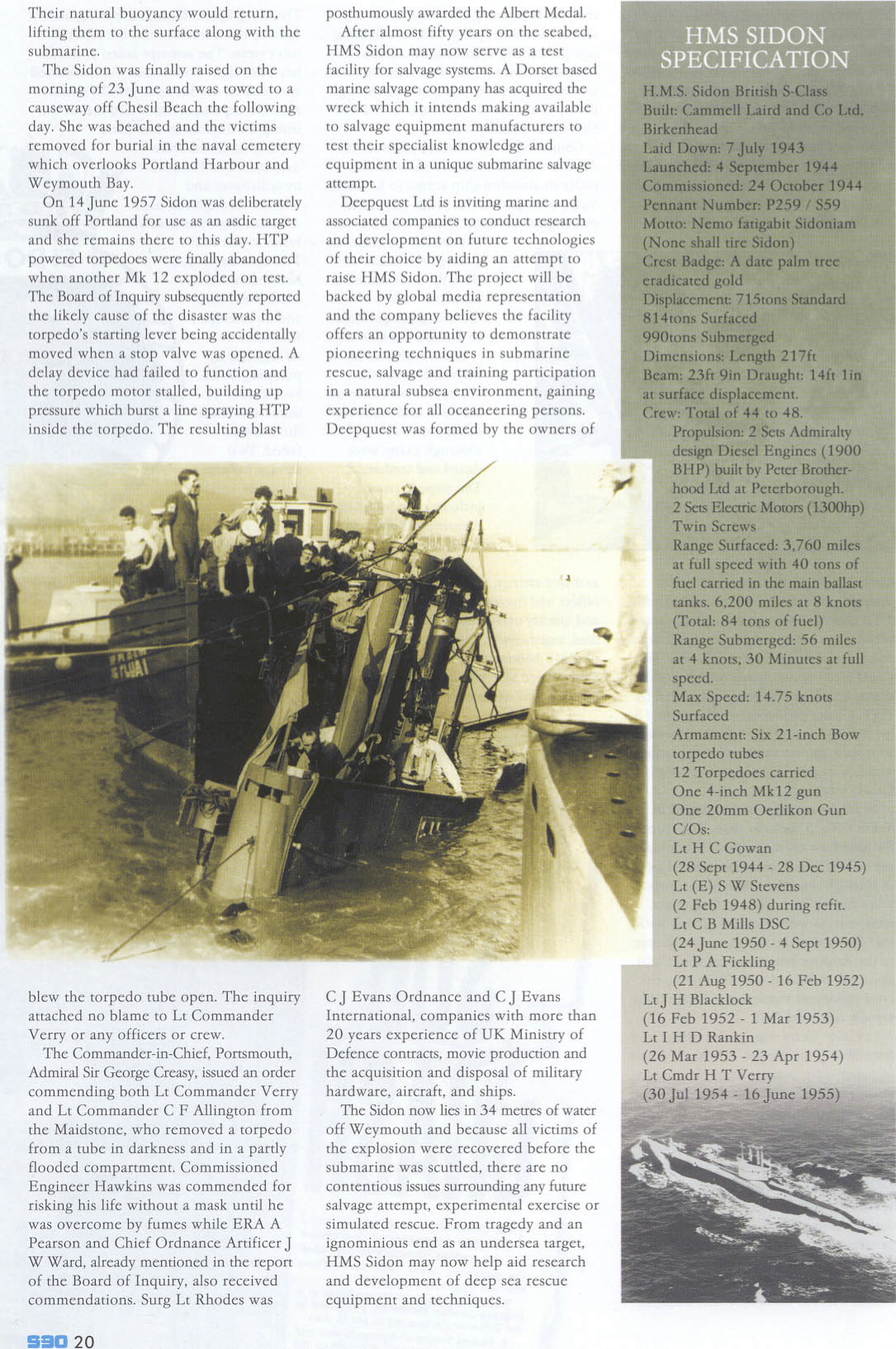
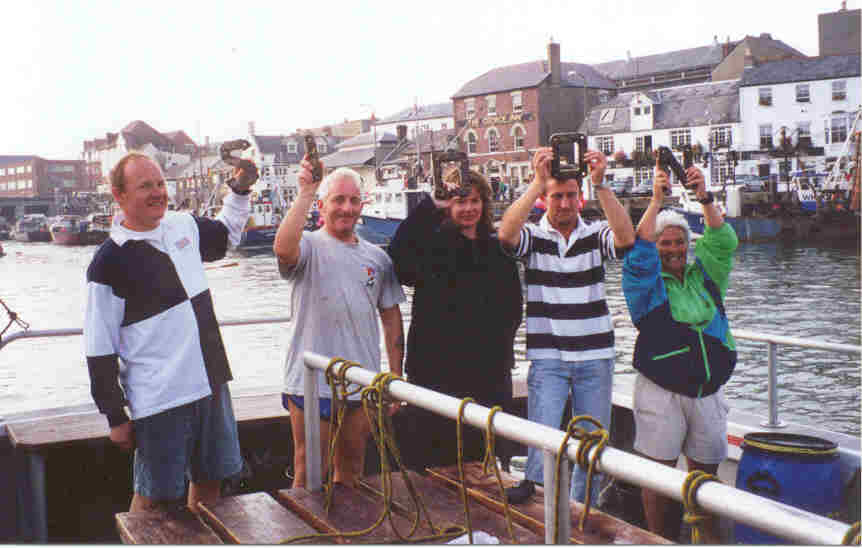
A graphic illustration of a tragic accident in 1955. The torpedoes on the submarine Sidon were driven by hydrogen peroxide; this propellant caused an explosion in the torpedo bay and she quickly sank, inside the Portland Naval Base. Thirteen crew were lost.
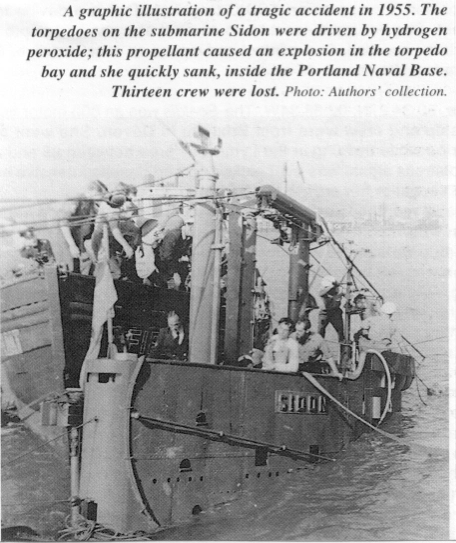
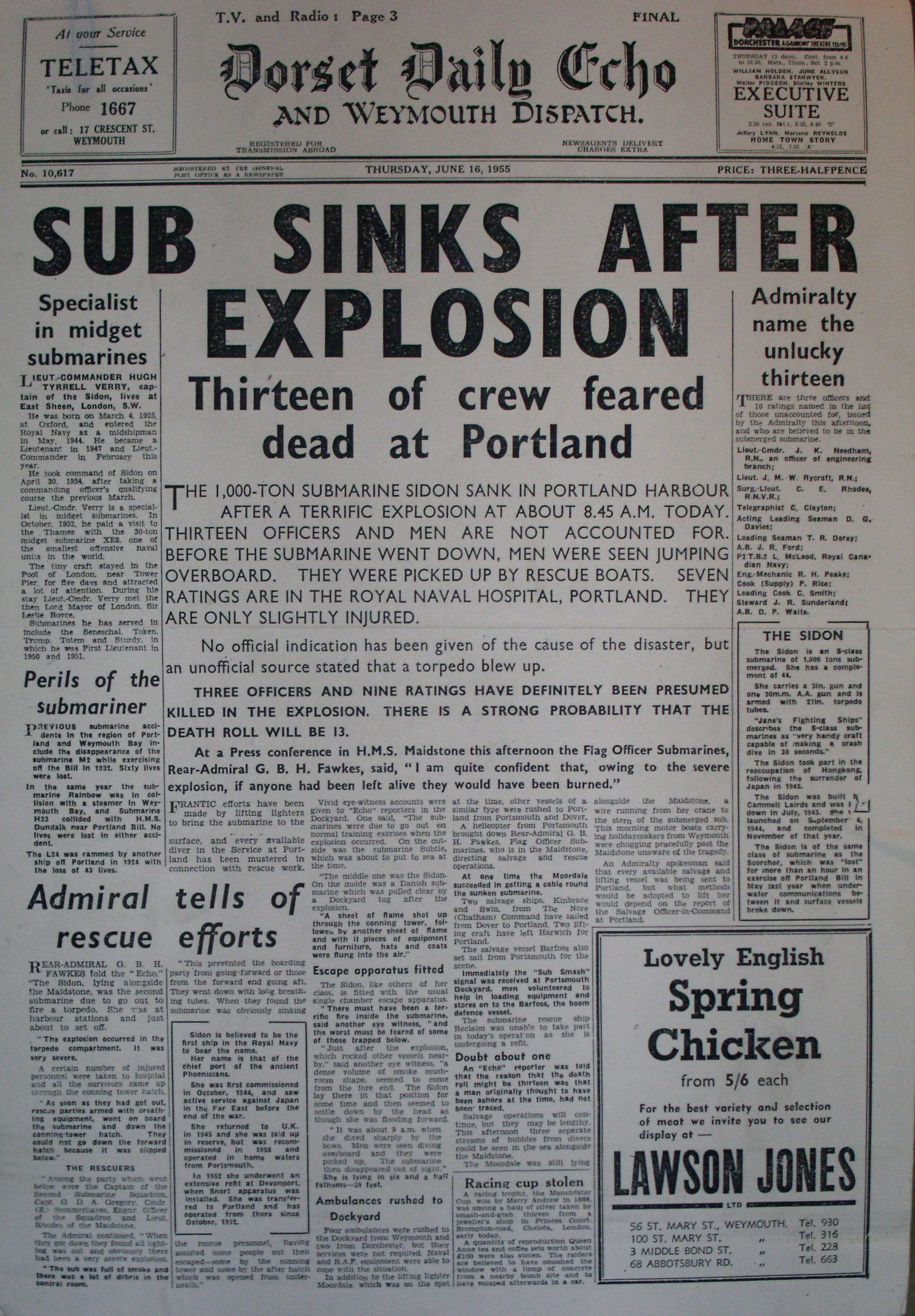
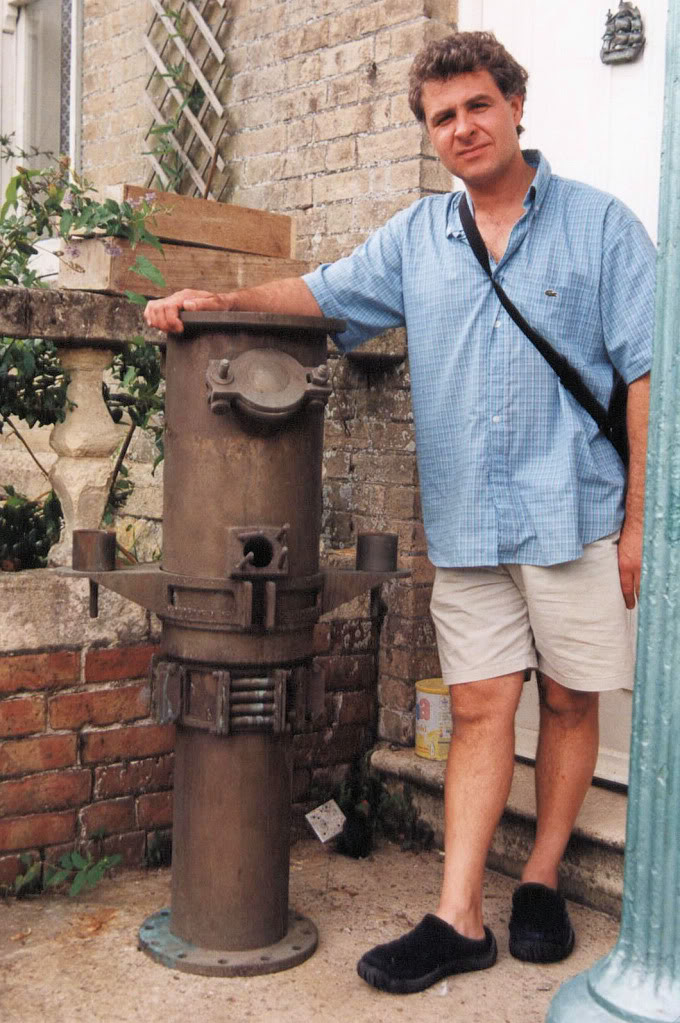
Submarine, S-class [36M]. – Captain Lieut. Cdr (RN) H. T. Verry. Dive Dorset: 66 p61 – 50 32.96N; 02 38.43W. Also Detail in LARN – 7 miles WNW of Portland Bill. (Clarke: p67, but there are mistakes?)
Day of Loss: 16
Month of Loss: 6
Year of Loss: 1955
Longitude: 50 32.96
Latitude: 02 38.43
Approximate Depth: 36
